E-learning is the use of networked information and communications technology in teaching and learning.
A number of other terms are also used to describe this mode of teaching and learning.
These are: online learning, virtual learning, distributed learning, network and web-based learning.
These description all refer to educational processes that utilize information and communications technology to mediate asynchronous as well as synchronous learning and teaching activities (Mantyla, 2001).
E-learning
- Definition 1: Usage of networked ICT in teaching and learning.
- Definition 2: Educational processes that use ICT to mediate asynchronous and synchronous learning.
Also described as:
- Online learning.
- Virtual learning.
- Distributed learning.
- Network and web-based learning.
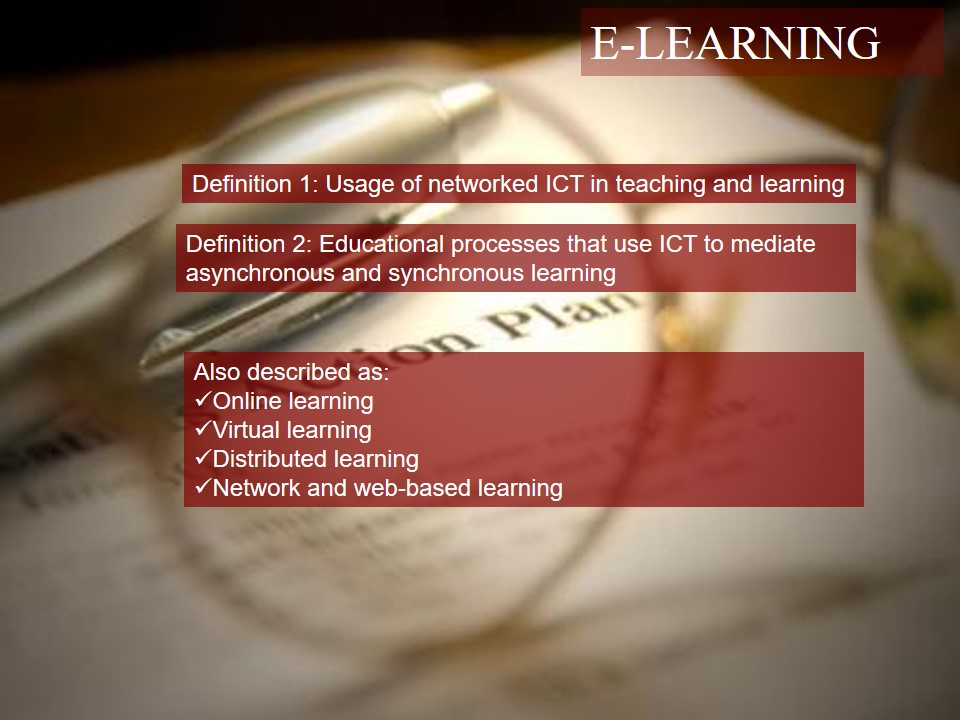
Modalities
- E-Learning:
- Individual self-paced:
- Online;
- Offline.
- Group-based:
- Synchronous;
- Asynchronous.
- Individual self-paced:
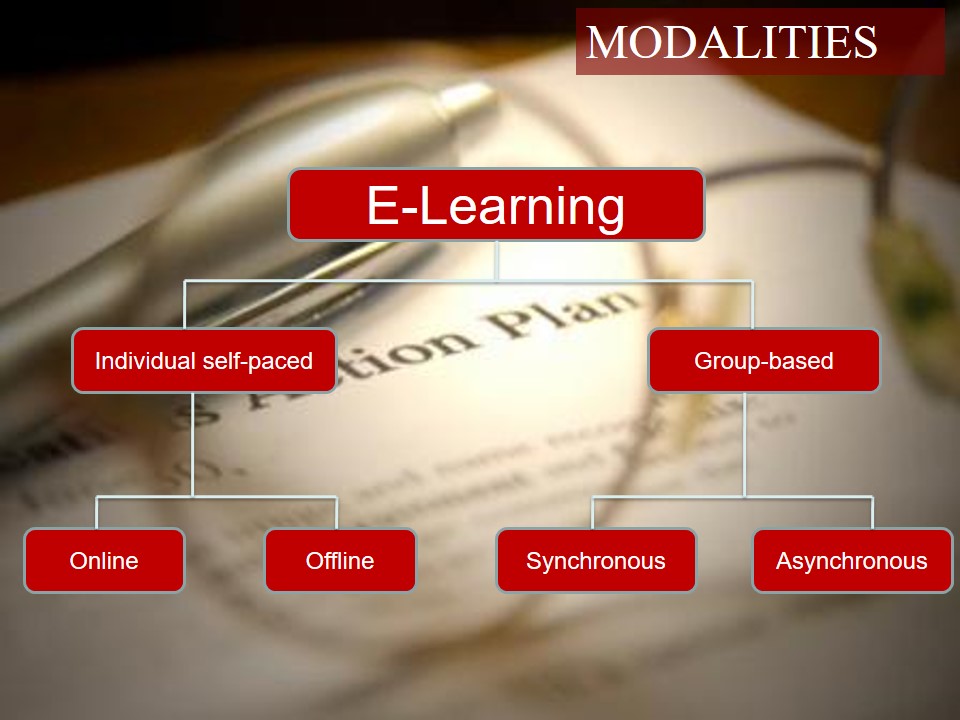
- Individualized self-paced e-learning – A learner accesses learning resources online via an Intranet or the Internet.
- Example: A learner studying alone or conducting some research on the Internet or a local network.
- Individualized self-paced e-learning offline-A learner uses learning resources such as a database or a computer-assisted learning package offline (i.e., while not connected to an Intranet or the Internet).
- Example: A learner working alone off a hard drive, a CD or DVD.
- Group-based e-learning synchronously-Groups of learners are working together in real time via an Intranet or the Internet
- Example: Learners engaged in a real-time chat or an audio-videoconference.
- Group-based e-learning asynchronously- Groups of learners work over an Intranet or the Internet where exchanges among participants occur with a time delay (i.e., not in real time).
- Example: On-line discussions via electronic mailing lists and text-based conferencing within learning managements systems
Individualized self-paced e-learning – situations where an individual learner is accessing learning resources such as a database or course content online via an Intranet or the Internet (Mantyla, 2001). A typical example is a learner studying alone or conducting some research on the Internet or a local network.
Individualized self-paced e-learning offline-Where an individual learner uses learning resources such as a database or a computer-assisted learning package offline (i.e., while not connected to an Intranet or the Internet) (Mantyla, 2001).
An example of this is a learner working alone off a hard drive, a CD or DVD.
Group-based e-learning synchronously refers to situations where groups of learners are working together in real time via an Intranet or the Internet. It may include text-based conferencing, and one or two-way audio and videoconferencing (Mantyla, 2001).
Examples of this include learners engaged in a real-time chat or an audio-videoconference.
Group-based e-learning asynchronously refers to arrangements where groups of learners work over an Intranet or the Internet where exchanges among participants occur with a time delay (i.e., not in real time).
Typical examples of this kind of activity include on-line discussions via electronic mailing lists and text-based conferencing within learning managements systems.
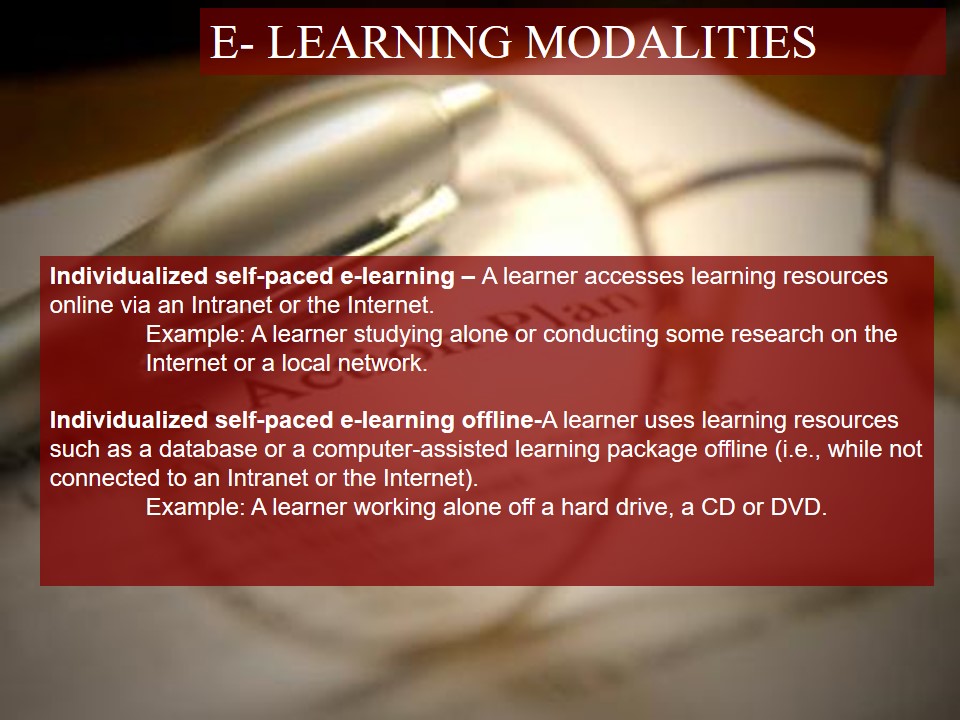
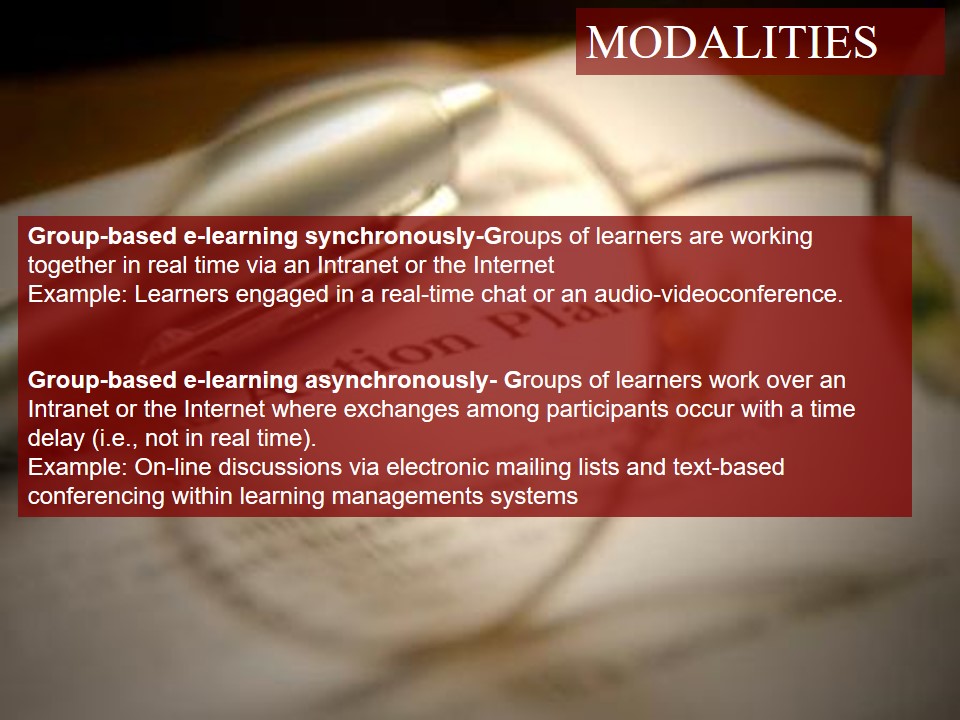
Instructional Techniques
Three instructional techniques for e-learning have been identified:
- Receptive: information acquisition.
- Directive: response strengthening.
- Guided Discovery: knowledge construction.
In their book eLearning and the Science of Instruction: Proven Guidelines for Consumers and Designers of Multimedia Learning, Ruth Colvin-Clark and Richard E.
Mayer identified three instructional techniques for e-learning. These are:
- Receptive: information acquisition.
- Directive: response strengthening.
- Guided Discovery: knowledge construction.

The receptive technique
This techniques emphasizes acquiring information and involves building instructional modules that open avenues to greater amounts of information while limiting application and experimentation.
This approach is also known as the Information Acquisition approach.
The receptive technique emphasizes acquiring information and involves building instructional modules that open avenues to greater amounts of information while limiting application and experimentation.

The directive technique
This approach emphasizes frequent responses from learners with immediate feedback from the instructor.
This technique is also known as response strengthening.
The directive technique emphasizes frequent responses from learners with immediate feedback from the instructor.
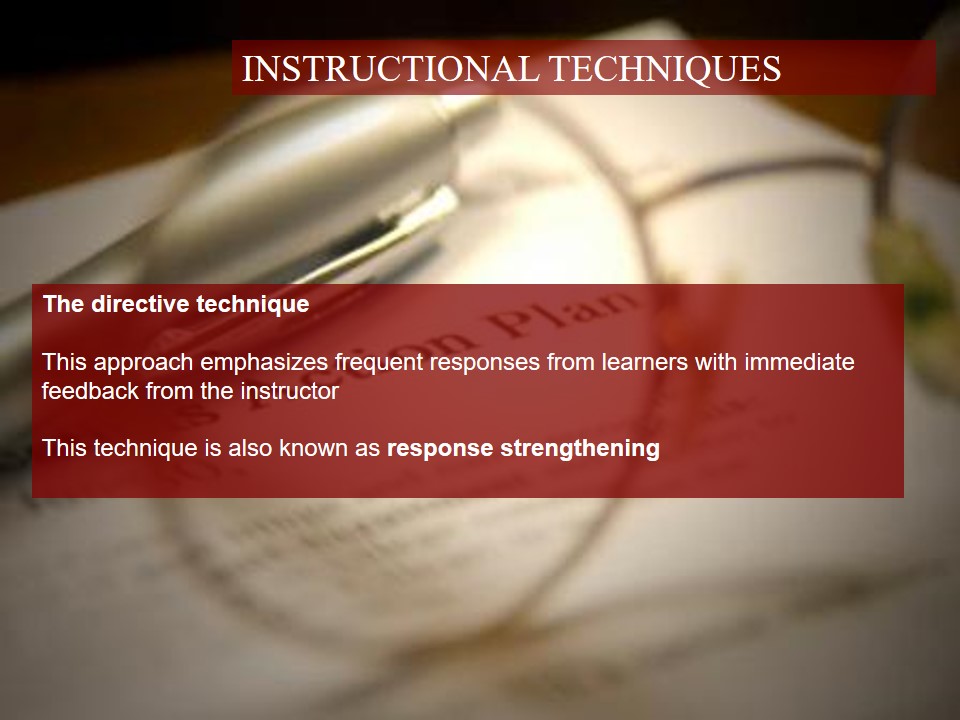
Guided discovery
In this techniques, the instructor leads students toward solving real-life challenges and identifying the appropriate conceptual codecs to support student knowledge acquisition.
This technique is also knowledge construction.
Guided discovery places the instructor in the role of expert who leads students toward solving real-life challenges and identifying the appropriate conceptual codecs to support student knowledge acquisition.
Blogging is a simple technology that can be used to construct learning environments that fulfill these three instructional techniques.
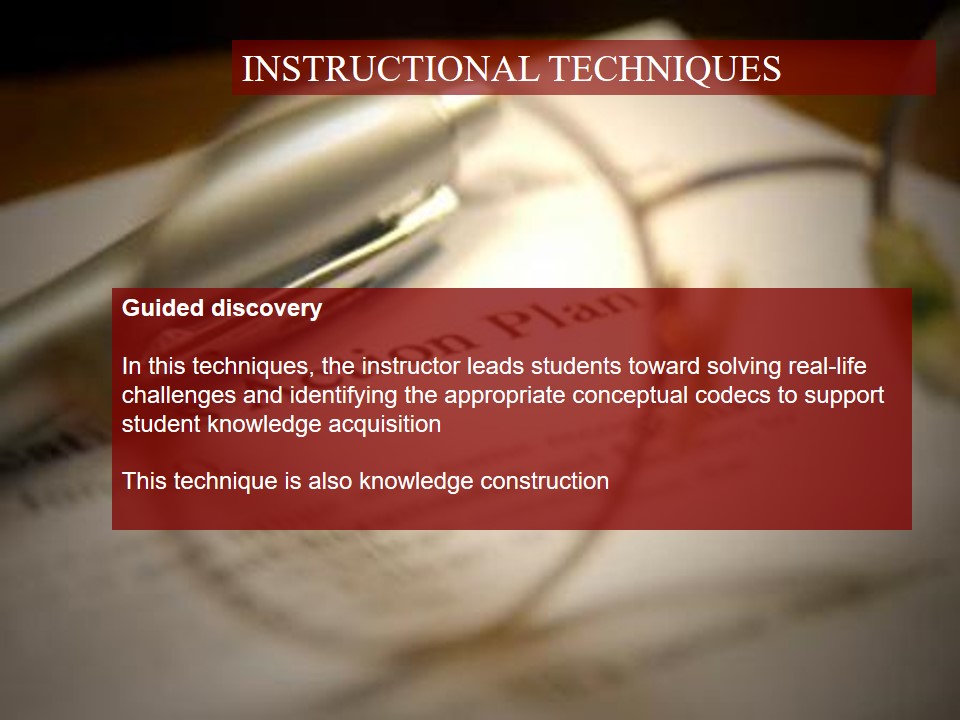
Cognitive Theory of Multimedia Learning & E-Learning
- Multimedia principle of learning-people learn more effectively from a combination of words and images than from words alone.
- Education, however, requires more than just adding words to pictures.
- The instructor has to understand how the human mind works before any strategy.
- This is the basis for the cognitive theory of multimedia learning.
The multimedia principle of learning states that people learn more deeply from words and pictures than from words alone (Mayer, 2001)
However, simply adding words to pictures is not an effective way to achieve multimedia learning.
The goal of any instructional procedure is to apply the relevant media in the light of how human mind works.
This is the basis for Mayer’s cognitive theory of multimedia learning (Moreno and Mayer, 1999).
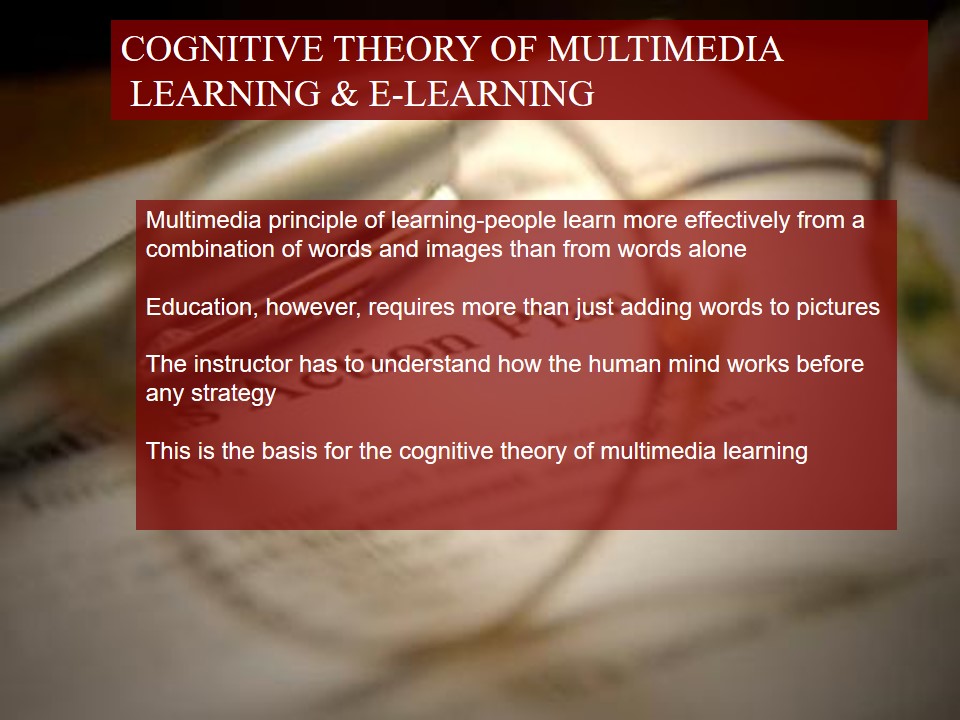
Mayer’s theory of multimedia learning
Has three assumptions:
- There are two separate channels.
- Each channel has a limited capacity.
- Learning is an active process of filtering, selecting, organizing, and integrating information.
This theory proposes three main assumptions when it comes to learning with multimedia:
- There are two separate channels (auditory and visual) for processing information.
- Each channel has a limited capacity.
- Learning is an active process of filtering, selecting, organizing, and integrating information based upon prior knowledge (Paivio, 1971).
Design principles for e-learning programs include providing coherent verbal, pictorial information, guiding the learners to select relevant words and images, and reducing the load for a single processing channel
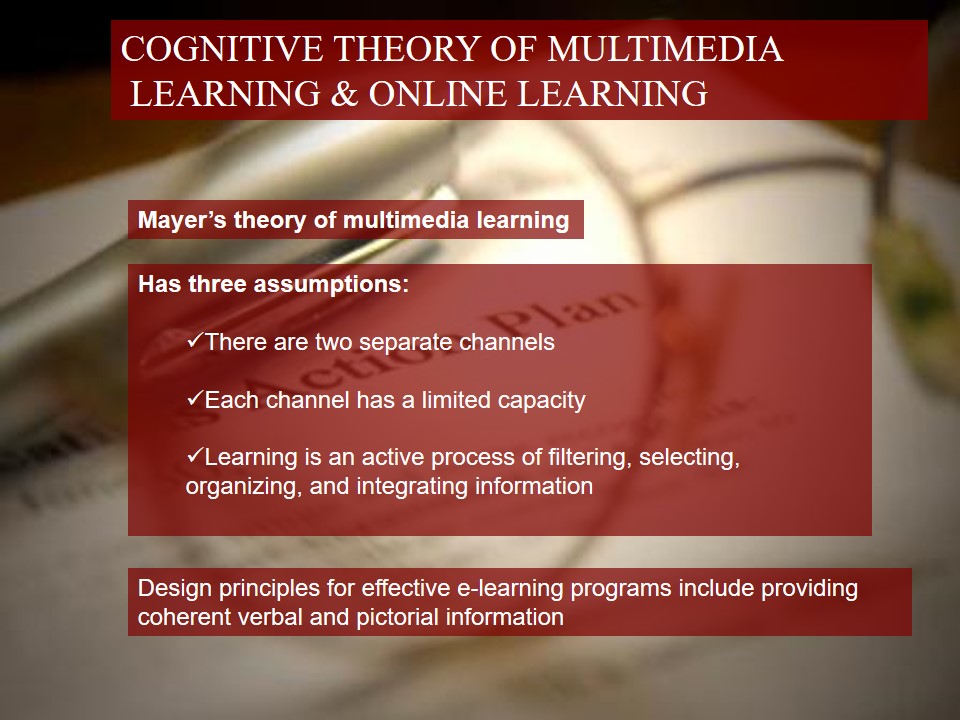
The Human-Brain and Storage of Information
Working memory: The working memory holds a limited amount of information at one time.
Long-term memory: The long-term memory holds all existing knowledge.
In the learning process, a person is connects new information to prior knowledge.
- Working memory:
- The working memory is good at processing information, but it can only hold so much at one time.
- All of a person’ active thinking happens in the working memory (Badley, 1974).
- Long-term memory: The long-term memory is the storage center and holds all existing knowledge.
- In the learning process, a person connects new information to prior knowledge.
- As he/she actively processes information, he/she swaps it between working and long-term memory
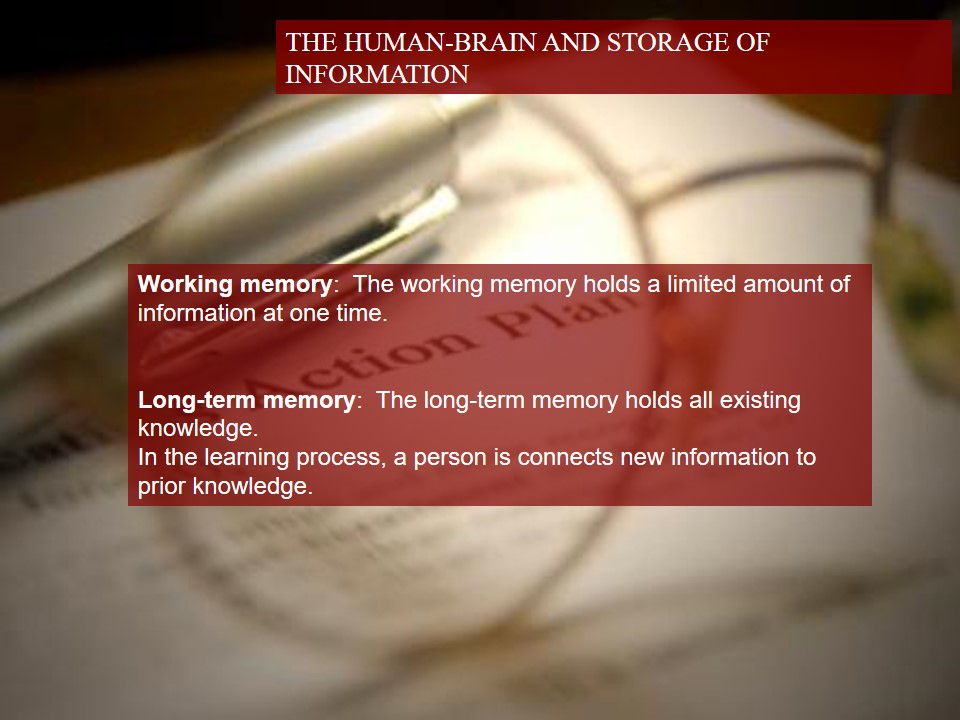
Designing an E-learning Programme for Working Memory
An individual goes through an e-learning course, what he/she sees and hears enters his/her working memory where it is temporarily stored.
The brain actively processes the new information and integrates it with what he/she has stored in his/her long-term memory.
So, his/her brain is :
- Receiving new information.
- Actively processing the information.
- Integrating the information with long-term memory.
The working memory has maximum capacity, at which it can store information, called the cognitive load.
Loading the working memory with too much information, leaves no room to process it.
Instead of just dumping information on the learner, designers structure the content by how the brain processes information.
The working memory has limited capacity and can only do so much. This is called the cognitive load (Horton, 2000).
If an individual loads his/her working memory with too much information, then there’s no room to process it, which makes it more difficult to recall the information later on.
This is where the e-learning design skills come in.
Instead of just dumping information on the learner, designers have an opportunity to guide the learner by structuring the content by how the brain processes information.
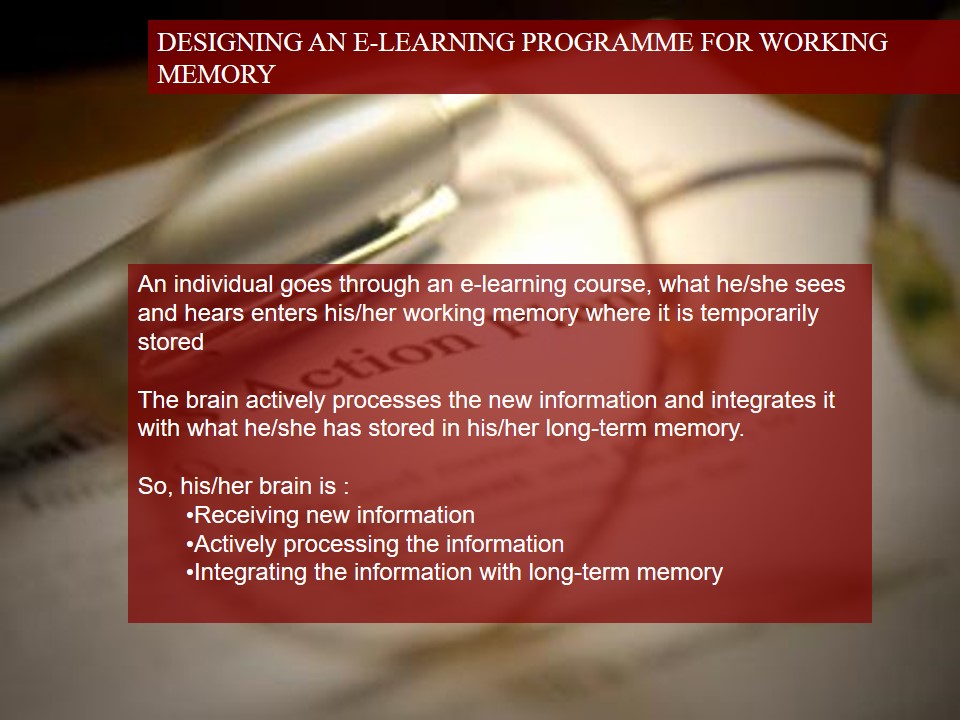
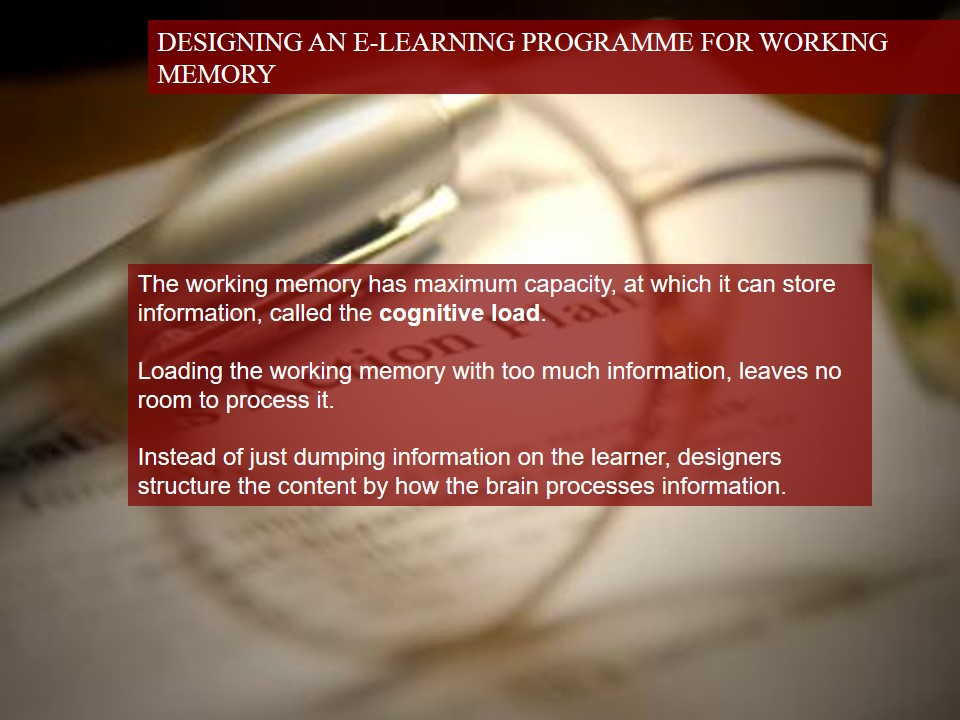
Strategies for structuring e-learning content
Organizing content into small chunks
- Structure new information in small, related chunks.
- The working memory should not be overloaded with irrelevant content.
- If information is not relevant, or there’s too much of it, it interferes with the learning process.

Building upon prior knowledge
Conditions should be created where the learner can practice using the information in a context that integrates it with prior experience.
Case studies and practices exercises can be structured to combine the new information with the learner’s current understanding.
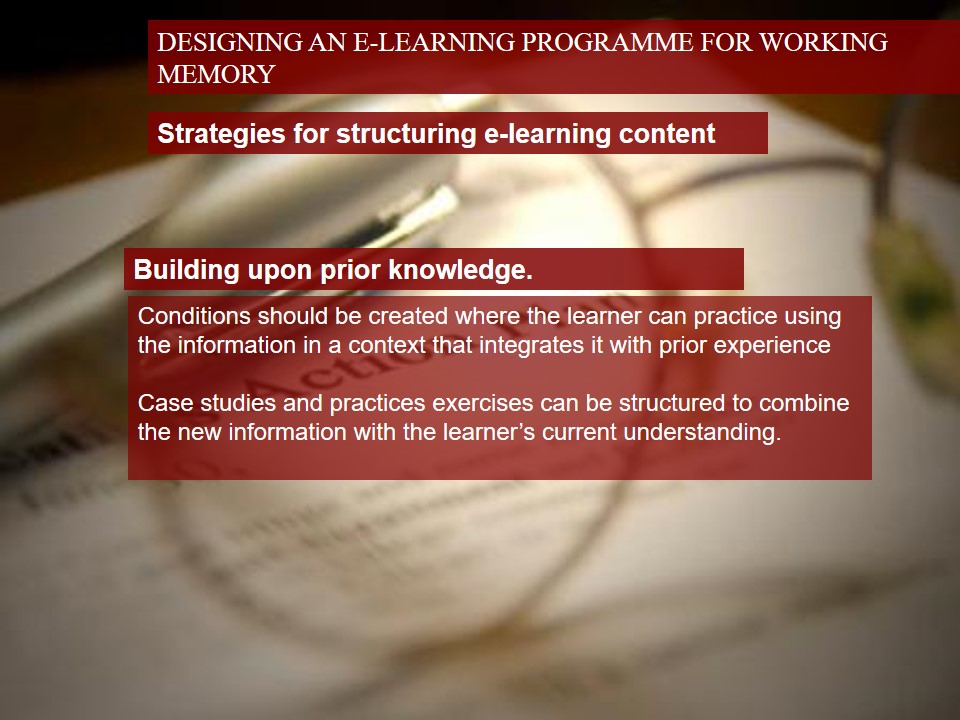
Provision of real-world contexts
- The designers of the module should develop exercises that help the learner apply the new information into a workplace context.
- Problem-solving scenarios help develop thinking skills that can be transferred to the real world.
- For effectiveness, the e-learning courses should be memorable.
- The tutors should identify how much information to share and how to present it to the learner.
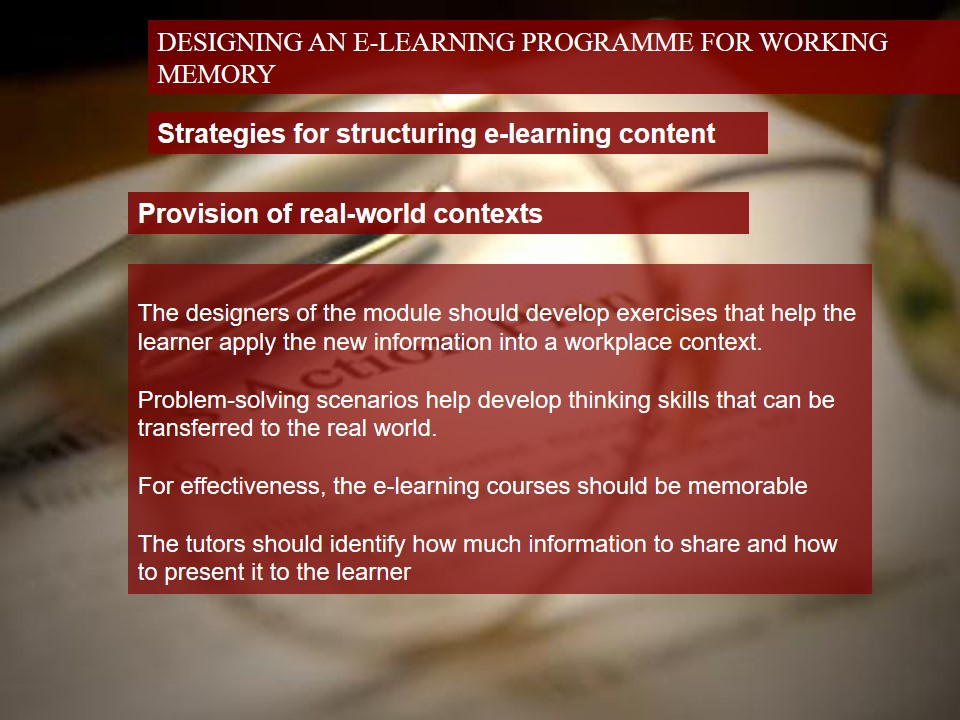
Reference List
The designers of the module should develop exercises that help the learner apply the new information into a workplace context.
Problem-solving scenarios help develop thinking skills that can be transferred to the real world.
For effectiveness, the e-learning courses should be memorable.
The tutors should identify how much information to share and how to present it to the learner.
Baddeley, A.D & Hitch G.J. (1974). “Working Memory”. In Bower, G.A. The psychology of learning and motivation: advances in research and theory. New York: Academic Press. pp. 47–89
Campbell, K. (2004). Effective writing for e-learning environments. New York: Idea Group Inc (IGI).
Horton, W. (2000). Designing Web-Based Training. New York: Wiley.
Kapp, K. M. (2001). Integrated Learning for ERP Success: A Learning Requirements Planning Approach. Florida: St. Lucie Press.
Mantyla, K. (2001). Blending E-Learning. USA: American Society for Training and Development.
Mayer, R. E. (2001). Multimedia learning. New York: Cambridge University Press.
Moreno, R., & Mayer, R. (1999). “Cognitive principles of multimedia learning: The role of modality and contiguity”. Journal of Educational Psychology 91: 358–368.
Paivio, A. (1971). Imagery and verbal processes. New York: Holt, Rinehart, and Winston.